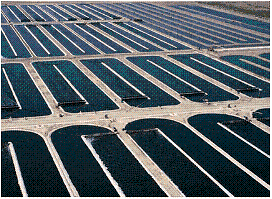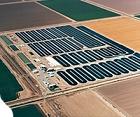Evolutionary History of Cyanobacteria
The cyanobacteria are believed to have evolved 3.5 billion years ago. Fossils discovered in the 3.5-Ga-old Apex chert in northwestern Western Australia bear filamentous cynobacteria. with strikingly similar morphologies to present-day ilamentouscynobacteria (Oscillatoriacea). The occurrence of aerobic respiration and oxygenic photosynthesis, photosynthetic carbon dioxide fixation like that of extant cynobacteria, cell division more similar to the extant cyanobacteria and recent rRNAanalyses showing that the Oscillatoriacea are among the earliest evolved also lend further evidence to the fossil record. Arthrospira belongs to the Class Oscillatoriacea and therefore has a very old lineage. Despite their old lineage, the fossil cb. are morphologically very similar to their extant forms, suggesting a slow evolutionary process. The cb. are the first group of bacteria that evolved that could fix atmospheric carbon dioxide into organic carbon compounds using water as an electron donor and thereby evolving oxygen. We owe the present oxygen-rich environment partially to the millions of years of photosynthetic activity by Cb. that made it possible for other life forms that are oxygen dependent to evolve. Indeed it is this same ability to fix carbon dioxide and produce organic matter that we arepresently utilizing in the mass cultivation of these organisms for food.
Spirulina Distribution in Nature
Species of the genus Arthrospira have been isolated from alkaline brackish and saline waters in tropical and subtropical regions. Among the various species included in the genus Arthrospira, A. platensis is the most widely distributed and is mainly found inAfrica but also in Asia. Arthrospira maxima is believed to be found in California and Mexico. It should be noted that the taxonomic distinction between these two species is based mainly on ultrastructural and morphological differences, some of which are hardly a distinctive feature in view of the morphological elasticity of these species under different growth and stress conditions. The recent 16s rRNA sequence data on 52 strains collected from various regions have revealed only two clusters with species from the various geographical areas represented in both clusters.
History of Human use as Food
Algae, especially the macroalgae, have been used as food since prehistoric times and still play a prominent role in the food traditions of many countries, particularly in Asia. The use of microalgae as food is fairly recent. Jasby cites numerous examplesof traditional use of microalgae as food spanning over four continents though the majority of the cases are from Asia as in the case of seaweeds or macroalgae. The first recorded history of the use of Arthrospira (Spirulina) as food comes from Bernal Diaz del Castillo, a member of Hernan Cortez’s troops who reported in 1521 that Spirulina maxima (A. maxima) was harvested from Lake excoco, dried, and sold for human consumption in a Tenochtitlan (today Mexico City) market. Bernal Diaz de Castillo described what he saw in the market as “… small cakes made from some sort of a ooze which they get out of the great lake, and from which they make a bread having a flavor something like cheese.” A few years later a Franciscan friar, Bernardino da Sahagun, described the food, then called Tecuitlatl, as “neither grass nor earth, rather like hay … of clear blue color … .” There was no mention of Tecuitlatl after the sixteenth century, though perhaps not surprisingly, the first commercial production of Spirulina started in Lake Texcoco in the 1970s. An interesting description of the history of Spirulina during the Aztec civilization is given by Farrar. The present Republic of Chad in Africa, about 10,000 km away from Lake Texcoco, provides additional evidence for the use of Spirulina as food. People have probably being using it for centuries, though it is not clear exactly since when. The recent historical evidence goes back to 1940 when the French phycologist, Dangeard published a paper about a cake called “dihe” and consumed by people of the Kanembu tribe, near Lake Chad in Africa. This report, which stayed unnoticed until the 1960s, described dihe as “a true filamentous, spiral shaped blue alga.” The alga described was Arthrospira (Spirulina) platensis that was also known to Dangeard to grow abundantly in the East African Rift Valley lakes where they represented the main source of food for the lesser flamingoes. Dihe was rediscovered 25 years later in 1966 by J. Leonard, who was attracted by a “curious substance green bluish, sold as driedbiscuits” around Fort Lamy.15 Leonard confirmed that dihe was composed almost exclusively of dried mats of S. platensis (A. latensis). It was collected from the waters of the alkaline lakes in the Kanem area, northeast of Lake Chad. Arthrospirastill makes a large portion of the daily protein diet of the Kanembu tribe in the Lake Chad area and contributes significantly to the local economy. It was at about the same time that the French Petroleum Institute got interested in some samples of Spirulina (S. maxima) that grew abundantly in Lake Texcoco near Mexico City. The subsequent studies by the French group culminated in the establishment of the first commercial production of Spirulina in the world in the 1970s.
Spirulina Production
Most of the information that is used to grow Spirulina in outdoor culture is derived from observations made on natural blooms of these algae in natural lakes. Of special significance is their adaptation to highly alkaline (up to 400 meq/l) and very high pH (up to 11) of tropical and subtropical regions of the world. This harsh chemical environment essentially prohibits the growth of other algae. It is therefore not uncommonto find almost unialgal populations of Arthrospira in these lakes. The crater lakes around the Great African Rift Valley are good examples of these. These lakes support high-standing crops of Spirulina (up to 2.0 g Chl a l−1) and support huge populations of flamingoes. It is estimated that adult and juvenile flamingoes consume on the average about 66 g of Spirulina per day on a dry weight basis. This means that the whole flamingo population, about a million individuals at the time, extracted 50–94% of the daily primary production or 0.4–0.6% of the algal biomass. The productivity of these natural ecosystems has not been studied to any great extent. However, there have been some studies looking into photosynthetic productivity. On the basis of these studies some of these soda lakes are among the most productive natural systems. The photosynthetic productivity reported for these lakes is the highest ever recorded for any natural systems and are comparable to those observed in some waste treatment ponds or mass culture facilities. The values of 43–57 g m−2 d−1 recorded by Talling for Lake Arenguadie in Ethiopia are among the highest ever recorded for natural systems. Comparable values have also been recorded recently for this same lake. The high productivity of these soda lakes is a result of (a) high algal contents in the euphotic zone, (b) high photosynthetic capacity favored by high temperature, and (c) a surplus of dissolved inorganic phosphate and an especially huge reserve of CO2. Maximal photosynthetic rates (mg C l−1 h−1) and photosynthetic efficiency (mg C [mg Chl a]−1 h−1) obtained at light saturation in a continuous culture replete with nutrients were comparable to those obtained in these highly productive lakes. Aerial biomass concentrations (mg Chl a m−2) for Lakes Arenguadie and Kilole have been found to be close to the maximum possible on theoretical grounds (180–300 mg Chl a m−2).
Large-scale, commercial production of Spirulina
Although the development of the technology of outdoor mass production of Spirulina dates back to the 1970s, it is very recently that its production and utilization has expanded beyond a few countries or producers. This is because of the many constraints that had to be surmounted. These relate to some environmental, physical, chemical, and biological problems encountered in commercial production of algae. It is notwithin the scope of this chapter to provide details of these constraints.


Earthrise Nutritionals LLC, the largest Spirulina producer in the world located in California, USA
Worldwide production of spirulina and its current use
Arthrospira (Spirulina) is currently grown commercially in several countries. The major producers of Spirulina are the DIC group of companies, Earthrise Nutritionals in California, USA; Hainan DIC Marketing in Hainan Island, China; and Siam Algae Company in Bangkok, Thailand. Together these facilities produce about 1000 metric tons of Spirulina annually. The other major producer is Cyanotech Corporation of Hawaii with an annual production of 300 tons of Spirulina. There are also many producers mainly from the Asia-Pacific region, especially in China and India.According to Wu, there were once between 100 and 120 producers of Spirulina in China with annual production ranging from 15 to 300 tons. Total production during that period was estimated to be about 500 tons. Current production of Spirulina in China is estimated to be about 1500 tons. It is difficult to know the total worldwide production of Spirulina. It is probably in the order of 3000–4000 metric tons. Currently Spirulina is used in various food application such as juice smoothies, confectionary, food bars, baked desserts, doughnuts, muffins, pasta, salad dressing, frozen desserts, snack foods, popcorn, corn chips, crackers, breakfast cereals, liquid or instant meals, instant soup, gnocchi, and even specialty beer. Spirulina is also widely used as an animal feed supplement. The increasing scientific and clinical evidence for its nutritional and potential health benefits is also attracting its use as a functional food in addition to its already established use as a dietary supplement.
*summarized from Spirulina in Human Nutrition and Health
Related articles
References and Footnotes:
1) Spirulina in Human Nutrition and Health, M.E. Gershwin and Amha Belay, 2008
2)
3)
4)
5)
Go from Cyanobacteria to Spirulina and Chlorella
Go from Cyanobacteria to Homepage
